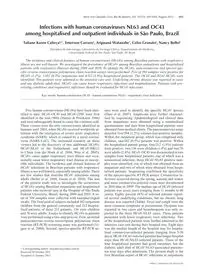
2012 Infections with human coronaviruses NL63 and OC43 among hospitalised and outpatient individuals in S_o Paulo, Brazi PDF
Preview 2012 Infections with human coronaviruses NL63 and OC43 among hospitalised and outpatient individuals in S_o Paulo, Brazi
693 online | memorias.ioc.fiocruz.br Mem Inst Oswaldo Cruz, Rio de Janeiro, Vol. 107(5): 693-694, August 2012 Five human coronaviruses (HCoVs) have been iden- tified to date. HCoV-OC43 and HCoV-229E were first identified in the mid-1960s (Hamre & Procknow 1966) and were subsequently found to cause the common cold. These viruses were the only coronaviruses identified in humans until 2003, when HCoVs received worldwide at- tention with the emergence of severe acute respiratory syndrome (SARS), which is caused by a novel corona- virus (SARS-CoV). The increased research on these viruses led to the discovery of two additional HCoVs: HCoV-NL63 in the Netherlands and HCoV-HKU1 in China (van der Hoek et al. 2004, Woo et al. 2005). HCoVs cause upper respiratory tract illness and occa- sionally cause lower respiratory tract disease in suscep- tible individuals. The incidence and clinical features of HCoV infections in Brazilian patients with respiratory illness is not well known, especially among adults. There are few studies that describe HCoV infections among adults (Bellei et al. 2008, Gaunt et al. 2010). The aim of the present study was to investigate the occurrence of HCoVs among Brazilian outpatients and hospitalised patients who received care at the Hospital of São Paulo Federal University, Brazil, during 2009 and 2010. A to- tal of 394 samples were collected with nasopharyngeal swabs. The final pool of subjects included 182 outpatient children from the general community and 212 hospita- lised patients; of these 212 patients, 136 were children and 76 were adults. Assays to identify HCoVs in patients were performed using a two-step process. First, an initial pancoronavirus reverse-transcription polymerase chain reaction (RT-PCR) screening assay was performed (Vi- jgen et al. 2008). Second, species-specific RT-PCR as- says were used to identify the specific HCoV species (Dare et al. 2007). Amplicons were further character- ised by sequencing. Epidemiological and clinical data from outpatients were obtained using a standardised questionnaire and data from hospitalised patients were obtained from medical charts. The pancoronavirus assay detected five/394 (1.2%) coronavirus-positive samples. Within the outpatient group, which was comprised only children, one/182 (0.5%) patients was positive. Within the hospitalised patient group, four/212 (1.8%) patients were positive: two/136 were children (1.4%) and two/76 were adults (2.6%). HCoV-OC43 was documented in two samples from hospitalised patients, one of which was a nosocomial infection; three HCoV-NL63 positive sam- ples were identified, one of which was obtained from an outpatient and two of which were obtained from hospi- talised patients. Sequencing confirmed the specificity of the species-specific RT-PCR assays. Coronavirus in- fections occurred during the spring, autumn and winter and more coronavirus-infected cases were documented in 2010 than in 2009. The median age of HCoV-infected patients was seven years (ranging from 11 months to 46 years). Eighty percent (4/5) of infected patients report- ed several underlying conditions, but no chronic lung disease was reported (Table). Fever and cough were the most common symptoms at presentation. Dyspnea was reported in two cases and bronchospasm was only re- ported in the three HCoV-NL63 cases. Three patients presented with lower respiratory tract infections. Two of the hospitalised patients were further admitted to the intensive care unit during their hospital stay. Eight days was the median length of the hospital stay for hospita- lised coronavirus-infected patients (ranging from 5-30 days). HCoV-OC43-infected patients had longer hospital stays than HCoV-NL63-infected patients. Three of the four hospitalised patients had good outcomes, but the diabetic adult died of HCoV-NL63-associated pneumo- nia nine days after admission. The present study is the first Brazilian report of HCoV infections in outpatients + Corresponding author:
